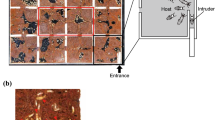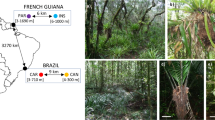Abstract
Social insect colonies typically have well-defined social and physical boundaries but in some cases, colonies may take-on a more diffuse form with no obvious nestmate recognition or inter-colony aggression. Why colonies adopt closed versus open societies is not well understood, but it is presumably related to the genetic or environmental identity of individuals. In this study, we use Canadian populations of the Eastern subterranean termite (Reticulitermes flavipes) to test for evidence of aggression and nestmate recognition. Specifically, we predict that any inter-colony aggression will increase as a function of geographic distance. In short-term, (5-min) Petri-dish trials (varying caste, group size and colony source) we observed no evidence of aggression. However, in 2- and 7-day shared-resource assays, we observed very little inter-colony mixing and a high incidence of mortality in non-nestmate pairings. Our long-term observations imply that subterranean termites sort and potentially compete on the basis of nest origin, and that this recognition is mediated in part by ecological context. This behavior would not be evident from Petri dish-style assays, which lack this context and may explain why prior studies of kin or nestmate recognition in R. flavipes have yielded mixed results.



Similar content being viewed by others
References
Adams ES (1991) Nest-mate recognition based on heritable odors in the termite Microcerotermes arboreus. Proc Nat Acad of Sci USA 88:2031–2034
Bernard S, Osbrink W, Su NY (2017) Response of the Formosan subterranean termite to neighboring con-specific populations after baiting with Noviflumuron. J Econ Entomol 110:575–583
Bagnères A-G, Hanus R (2015) Communication and social regulation in termites. Social recognition in invertebrates. Springer, Switzerland, pp 193–248
Breed MD (2003) Nestmate recognition assays as a tool for population and ecological studies in eusocial insects: a review. J Kans Entomol Soc 76:539–550
Breed MD (2014) Kin and nestmate recognition: the influence of WD Hamilton on 50 years of research. Anim Behav 92:271–279
Bulmer MS, Traniello JFA (2002a) Foraging range expansion and colony genetic organization in the subterranean termite Reticulitermes flavipes (Isoptera: Rhinotermitidae). Environ Entomol 31:293–298
Bulmer MS, Traniello JFA (2002b) Lack of aggression and spatial association of colony members in Reticulitermes flavipes. J Ins Behav 15:121–126
Bulmer MS, Adams ES, Traniello JF (2001) Variation in colony structure in the subterranean termite Reticulitermes flavipes. Behav Ecol Sociobiol 49:236–243
Chouvenc T, Bardunias P, Li HF, Elliott ML, Su NY (2011) Planar arenas for use in laboratory bioassay studies of subterranean termites (Rhinotermitidae). Fla Entomol 94:817–826
Chouvenc T, Su NY (2017) Testing the role of cuticular hydrocarbons on intercolonial agonism in two subterranean termite species (Coptotermes) and their hybrids. Ins Soc 64:347–355
Clément J, Lemaire M, Nagnan P, Escoubas P, Bagneres A, Joulie C (1988) Chemical ecology of European termites of the genus Reticulitermes: allomones, pheromones and kairomones. Sociobiology (USA) 14:165–174
Clément J-L (1986) Open and closed societies in Reticulitermes termites (Isoptera, Rhinotermitidae): geographic and seasonal variations. Sociobiology 11:311–323
Clément J-L, Bagnères A-G (1998) Nestmate recognition in termites. In: Vander Meer RK, Breed MD, Winston ML, Espelie KE (eds) Pheromone communication in social insects: ants, wasps, bees, and termites. Westview Press, Boulder, pp 126–155
Costa-Leonardo AM, Haifig I (2014) Termite communication during different behavioral activities. Biocommunication of animals. Springer, Netherlands, pp 161–190
Cornelius ML, Osbrink WL (2000) Interspecific interaction between Coptotermes formosanus and Reticulitermes flavipes (Isoptera: Rhinotermitidae) in laboratory assays. J Insect Behav 13:757–770
Cornelius ML, Osbrink WL (2003) Agonistic interactions between colonies of the Formosan subterranean termite (Isoptera: Rhinotermitidae) in New Orleans, Louisiana. Environ Entomol 32:1002–1009
DeHeer CJ, Vargo EL (2004) Colony genetic organization and colony fusion in the termite Reticulitermes flavipes as revealed by foraging patterns over time and space. Mol Ecol 13:431–441
DeHeer CJ, Vargo EL (2008) Strong mitochondrial DNA similarity but low relatedness at microsatellite loci among families within fused colonies of the termite Reticulitermes flavipes. Insect Soc 55:190–199
DeHeer CJ, Kamble CJ, Shiprat T (2008) Colony genetic organization, fusion and inbreeding in Reticulitermes flavipes from the Midwestern US. Sociobiology 51:307–325
Dronnet S, Chapuisat M, Vargo EL, Lohou C, Bagnères AG (2005) Genetic analysis of the breeding system of an invasive subterranean termite, Reticulitermes santonensis, in urban and natural habitats. Mol Ecol 14:1311–1320
Fisher ML, Gold RE (2003) Intercolony aggression in Reticulitermes flavipes (Isoptera: Rhinotermitidae). Sociobiology 42:651–661
Fisher ML, Gold RE, Vargo EL, Cognato AI (2004) Behavioral and genetic analysis of colony fusion in Reticulitermes flavipes (Isoptera: Rhinotermitidae). Sociobiology 44:565–576
Florane CB, Bland JM, Husseneder C, Raina AK (2004) Diet-mediated inter-colonial aggression in the Formosan subterranean termite Coptotermes formosanus. J Chem Ecol 30:2559–2574
Grace JK (1990) Mark-recapture studies with Reticulitermes flavipes. Sociobiology 16:3
Grace JK (1996) Absence of overt agonistic behavior in a northern population of Reticulitermes flavipes (Isoptera, Rhinotermitidae). Sociobiology 28:103–110
Hamilton WD (1972) Altruism and related phenomena, mainly in social insects. Annu Rev Ecol Syst 3:193–232
Huang Q, Sun P, Zhou X, Lei C (2012) Characterization of head transcriptome and analysis of gene expression involved in caste differentiation and aggression in Odontotermes formosanus (Shiraki). PLoS One 7:e50383
Husby WD (1980) Biological studies on Reticulitermes flavipes (Kollar) (Dictuoptera, Rhinotermitidae) in southern Ontario. Unpublished MSc thesis, University of Guelph, pp 154
Kaib M, Brandl R (1992) Distribution, geographic variation and between-colony compatibility of Schedorhinotermes lamanianus in Kenya (Isoptera: Rhinotermitidae). In: Billen J (ed) Biology and evolution of social insects. Leuven UP, Leuven, pp 121–131
Kirby CS (1965) The distribution of termites in Ontario after 25 years. Can Entomol 97:310–314
Korb J, Buschmann M, Schafberg S, Liebig J, Bagnères A-G (2012) Brood care and social evolution in termites. Proc R Soc Lond B Biol Sci 279:2662–2671
Li HF, Yang RL, Su NY (2010) Interspecific competition and territory defense mechanisms of Coptotermes formosanus and Coptotermes gestroi (Isoptera:Rhinotermitidae). Environ Entomol 39:1601–1607
Luscher M (1949) Continuous observation of termites in laboratory cultures. Acta Trop 6:161–165
Matsuura K (2001) Nestmate recognition mediated by intestinal bacteria in a termite, Reticulitermes speratus. Oikos 92:20–26
Matsuura K, Nishida T (2001) Colony fusion in a termite: what makes the society “open”? Insect Soc 48:378–383
Messenger MT, Su NY (2005) Agonistic behavior between colonies of the Formosan subterranean termite (Isoptera: Rhinotermitidae) from Louis Armstrong Park, New Orleans, Louisiana. Sociobiology 45:1–15
Myles TG (1996) Development and evaluation of a transmissible coating for control of subterranean termites. Sociobiology 28:373–457
Nalepa CA, Jones SC (1991) Evolution of monogamy in termites. Biol Rev 66:83–97
Neoh KB, Yeap BK, Tsunoda K, Yoshimura T, Lee CY (2012) Do termites avoid carcasses? Behavioral responses depend on the nature of the carcasses. PLoS One 7:1–11
Perdereau E, Dedeine F, Christides JP, Dupont S, Bagnères AG (2011) Competition between invasive and indigenous species: an insular case study of subterranean termites. Biol Invasions 13:1457–1470
Perdereau E, Bagnères AG, Vargo EL, Baudouin G, Xu Y, Labadie P, Dupont S, Dedeine F (2015) Relationship between invasion success and colony breeding structure in a subterranean termite. Mol Ecol 24:2125–2142
Polizzi J, Forschler B (1998) Intra-and interspecific agonism in Reticulitermes flavipes (Kollar) and R. virginicus (Banks) and effects of arena and group size in laboratory assays. Insect Soc 45:43–49
Polizzi JM, Forschler BT (1999) Factors that affect aggression among the worker caste of Reticulitermes spp. subterranean termites (Isoptera: Rhinotermitidae). J Ins Behav 12:133–146
Preswitch GD (1984) Defense mechanisms of termites. Ann Rev Entomol 29:201–232
R Core Team (2015) R: a language and environment for statistical computing. R Foundation for Statistical Computing, Vienna
Raffoul M, Hecnar SJ, Prezioso S, Hecnar DR, Thompson GJ (2011) Trap response and genetic structure of Eastern subterranean termites (Isoptera, Rhinotermitidae) in Point Pelee National Park, Ontario, Canada. Can Entomol 143:263–271
Scaduto DA, Garner SR, Leach EL, Thompson GJ (2012) Genetic evidence for multiple invasions of the Eastern subterranean termite into Canada. Environ Entomol 41:1680–1686
Shellman-Reeve JS (1997) The spectrum of eusociality in termites. In: Choe JC, Crespi BJ (eds) The evolution of social behavior in insects and arachnids. Cambridge University Press, Cambridge, pp 52–93
Shelton TG, Grace JK (1996) Review of agonistic behaviors in the Isoptera. Sociobiology 28:155–176
Šobotník J, Jirošová A, Hanus R (2010) Chemical warfare in termites. J Insect Physiol 56:1012–1021
Su N-Y, Ban PM, Scheffrahn RH (1991) Evaluation of twelve dye markers for population studies of the eastern and Formosan subterranean termite (Isoptera: Rhinotermitidae). Sociobiology 19:349–362
Sun Q, Zhou X (2013) Corpse management in social insects. Int J Biol Sci 9:313–321
Sun Q, Haynes KF, Zhou X (2013) Differential undertaking response of a lower termite to congeneric and conspecific corpses. Sci Rep 3:1–8
Thorne BL (1982) Termite-termite interactions: workers as an agonistic caste. Psyche 89:133–150
Thorne BL, Haverty MI (1991) A review of intracolony, intraspecific, and interspecific agonism in termites. Sociobiology 19:115–145
Thorne BL, Traniello JFA, Adams ES, Bulmer M (1999) Reproductive dynamics and colony structure of subterranean termites of the genus Reticulitermes (Isoptera Rhinotermitidae): a review of the evidence from behavioral, ecological, and genetic studies. Ethol Ecol Evol 11:149–169
Urquhart FA (1953) The introduction of the termite in Ontario. Canad Entomol 85:292–293
Vargo EL, Husseneder C (2009) Biology of subterranean termites: insights from molecular studies of Reticulitermes and Coptotermes. Annu Rev Entomol 54:379–403
Acknowledgements
We thank Aetna Pest Control (Toronto), the Nature Conservancy of Canada and Point Pelee National Park for permission and assistance in obtaining field colonies. This work was funded by NSERC Discovery Grants to GJT and JNM.
Author information
Authors and Affiliations
Corresponding author
Electronic supplementary material
Below is the link to the electronic supplementary material.
Rights and permissions
About this article
Cite this article
Simkovic, V., Thompson, G.J. & McNeil, J.N. Testing for aggression and nestmate recognition in the Eastern subterranean termite (Reticulitermes flavipes). Insect. Soc. 65, 281–288 (2018). https://doi.org/10.1007/s00040-018-0608-9
Received:
Revised:
Accepted:
Published:
Issue Date:
DOI: https://doi.org/10.1007/s00040-018-0608-9




